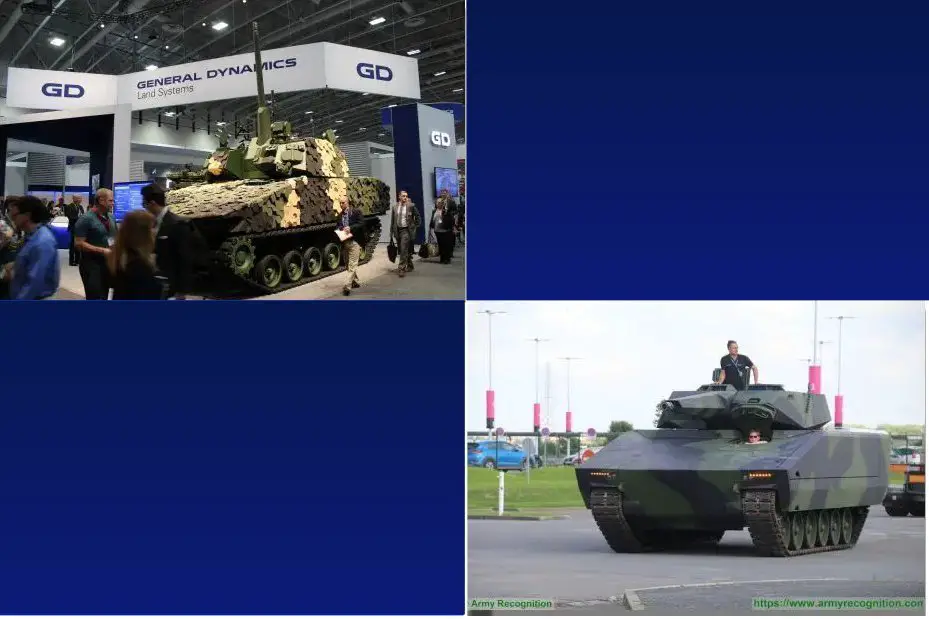Breaking news
US Army selects Rheinmetall & GDLS to proceed in XM30 OMFV program.
The United States Army announced on 26 June 2023 the approval of contracts with General Dynamics Land Systems and American Rheinmetall Vehicles for the next phases of its Optionally Manned Fighting Vehicle (OMFV) program. Along with the contract announcements, the US Army has also unveiled the new name for the program: the XM30 Mechanized Infantry Combat Vehicle.
Follow Army Recognition on Google News at this link

General Dynamics Land Systems' Griffin III and Rheinmetall Vehicles' Lynx KF41. (Picture source: Army Recognition)
The XM30 represents the Army's latest endeavor to replace the aging Bradley Fighting Vehicle, a project that has been in progress since the cancellation of the Future Combat Systems program in 2009.
Over the years, various programs have been developed, including the Ground Combat Vehicle and the Next Generation Combat Vehicle Program, ultimately leading to the OMFV, now rebranded as the XM30.
The two selected vehicles, General Dynamics Land Systems' Griffin III and American Rheinmetall Vehicles' Lynx KF41, boast remarkable technical features. The Griffin III is a light tank concept based on the Ajax platform, equipped with a 50mm automatic cannon that offers 360-degree rotation and an elevation range from +85 to -20 degrees.
It incorporates an Active Protection System (APS) developed by IMI Systems, providing defense against anti-tank missiles and tank rounds. On the other hand, the Lynx KF41 is a versatile combat vehicle that can be configured as an Infantry Fighting Vehicle (IFV), armored personnel carrier, command vehicle, recovery vehicle, or ambulance.
It features a common drive module and a flexible mission kit arrangement. The Lynx KF41 is equipped with a manned turret offering multiple armament options, including a 30mm or 35mm automatic cannon, a coaxial machine gun, guided missiles, and machine guns. It also incorporates modular protection systems, an Active Protection System (APS), and advanced optronics for enhanced situational awareness.
The two competitors prioritize mobility and agility, with cutting-edge performance tailored to modern combat requirements. The Griffin III offers an excellent power-to-weight ratio, reaching speeds of up to 70 km/h and a maximum cruising range of 500 km.
The Lynx KF41, powered by an 850 kW (1140 hp) Liebherr engine, can also achieve a top speed of 70 km/h, with a cruising range of 500 km. Both vehicles are designed to overcome various terrain obstacles and provide operational versatility through their modular configuration.
The XM30 will be therefore a tracked combat vehicle capable of accommodating a crew of two and carrying up to six passengers. It will be equipped with advanced features, including a 50mm cannon mounted on a remote turret, guided missiles, and machine guns. Brig. Gen. Geoff Norman, the leader of the next generation combat vehicle cross-functional team, emphasized the utilization of advanced third-generation software and intelligent control systems for these weapons.
The awarded contracts encompass Phases III and IV, which involve detailed design, prototype build, and testing phases. The total value of these contracts amounts to approximately $1.6 billion.
The so-called XM30 has been developed with a modular open system architecture, allowing for the integration of emerging technologies as they mature. This approach ensures that the vehicle will maintain a competitive edge against potential adversaries in the future.
In the forthcoming phases of the program, the Army will focus on refining the XM30 designs and validating prototype performance through rigorous testing, including a limited user test. The contractors will be responsible for delivering up to 11 prototype vehicles, along with two ballistic hulls and turrets, armor coupons, and digital engineering data.
Upon the completion of the detailed design and prototype build and testing phases, the Army intends to initiate a limited competition to select a single vendor at Milestone C, expected towards the end of the year 2027.
The goal is to have the first units equipped with the XM30 by the year 2029. Furthermore, the selected vendors will have the opportunity to compete for the low-rate initial production of the XM30 based on their demonstrated platform performance, as stated by Maj. Gen. Glenn Dean, the program executive officer for ground combat systems.
The selection of American Rheinmetall and General Dynamics Land Systems as the finalists to build the replacement for the M2 Bradley infantry fighting vehicle represents a significant step forward in a project that has faced numerous challenges.
With a focus on technological advancements, such as hybrid-electric designs and active protection systems, the project aims to deliver a more compact and advanced combat vehicle. The Army's flexible approach provides optimism for the successful development of prototypes and eventual full-scale production, signaling a positive outlook for the long-awaited replacement of the Bradley vehicle.


























